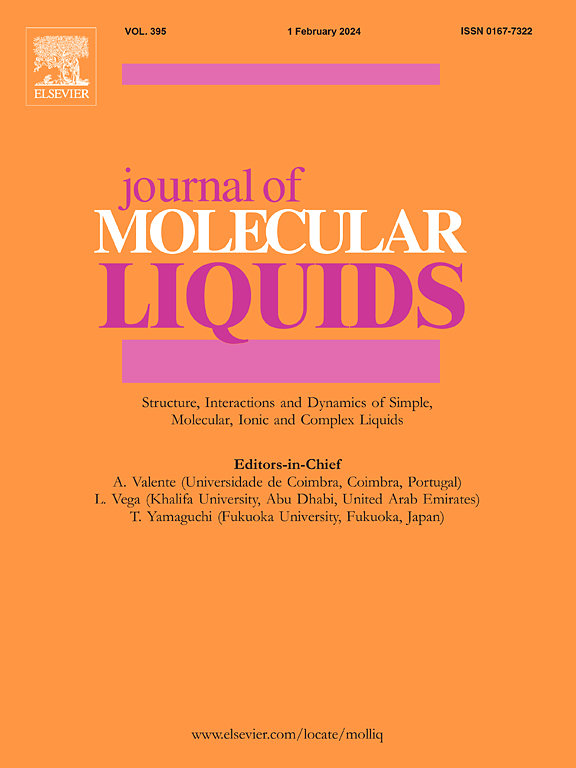Thermodynamic modeling and solubility behavior of etoricoxib in different mono-solvents at different temperatures
IF 5.3
2区 化学
Q2 CHEMISTRY, PHYSICAL
引用次数: 0
Abstract
Thermodynamic models for correlating the solubility of drugs in water and organic solvents have a practical importance in design and development of new products in pharmaceutical and chemical industries. Solubility data of etoricoxib (ETR) are scarce in the research literature. Thus the present investigation pertains to the utility of various thermodynamic models including van’t Hoff model, Apelblat model, and Buchowski-Ksiazczak model for solubility correlation of ETR in eighteen different mono-solvents, namely, methanol (MeOH), ethanol (EtOH), 1-propanol (1-PrOH), 2-propanol (2-PrOH), formamide, 1,4-dioxane, N,N-dimethyl formamide (DMF), N,N-dimethyl acetamide (DMA), dimethyl sulfoxide (DMSO), N-methyl-2-pyrrolidone (NMP), ethylene glycol (EG), propylene glycol (PG), 1,4-butanediol (BDOH), glycerin, polyethylene glycol-200 (PEG-200), PEG-400, PEG-600, and water at five different temperatures (T = 293.2 K to 313.2 K) and atmospheric pressure (p = 0.1 MPa). The solid state characterization by fourier transform Raman spectroscopy (FT-Raman), X-ray powder diffraction analysis (XRPD), and differential scanning calorimetry (DSC) confirmed no transformation of ETR into polymorphs. The mole fraction solubility of ETR was recorded the highest in PEG-600 (4.558 × 10-1) and lowest in water (2.439 × 10-5) at 313.2 K. The activity coefficients were calculated with the help of ideal solubilities, and found the highest molecular interaction between ETR and PEG-600. Moreover, apparent thermodynamic treatment of solubility data of ETR indicated an endothermic, spontaneous, and an entropy-driven dissolution process in all eighteen mono-solvents investigated. Thus, these reported thermodynamic parameters provide useful information for better understanding of dissolution of ETR.

不同温度下依托昔布在不同单溶剂中的溶解度及热力学建模
描述药物在水和有机溶剂中的溶解度的热力学模型在制药和化学工业新产品的设计和开发中具有重要的实际意义。依托昔布(ETR)的溶解度数据在研究文献中很少。因此,本研究涉及各种热力学模型的应用,包括van 't Hoff模型,Apelblat模型和Buchowski-Ksiazczak模型,用于研究ETR在十八种不同的单溶剂中的溶解度相关性,即甲醇(MeOH),乙醇(EtOH), 1-丙醇(1- proh), 2-丙醇(2-PrOH),甲酰胺,1,4-二氧环,N,N-二甲基甲酰胺(DMF), N,N-二甲基乙酰胺(DMA),二甲基亚砜(DMSO), N-甲基-2-吡啶酮(NMP),乙二醇(EG),丙二醇(PG)、1,4-丁二醇(BDOH)、甘油、聚乙二醇-200 (PEG-200)、PEG-400、PEG-600和水在五种不同温度(T = 293.2 K至313.2 K)和大气压(p = 0.1 MPa)下的反应。傅里叶变换拉曼光谱(FT-Raman)、x射线粉末衍射分析(XRPD)和差示扫描量热法(DSC)的固态表征证实了ETR没有转变成多晶态。在313.2 K时,ETR在PEG-600中的溶解度最高(4.558 × 10-1),在水中最低(2.439 × 10-5)。利用理想溶解度计算活度系数,发现ETR与PEG-600的分子相互作用最高。此外,对ETR溶解度数据的表观热力学处理表明,在所有18种所研究的单溶剂中,ETR的溶解过程都是吸热的、自发的和熵驱动的。因此,这些报道的热力学参数为更好地理解ETR的溶解提供了有用的信息。
本文章由计算机程序翻译,如有差异,请以英文原文为准。
求助全文
约1分钟内获得全文
求助全文
来源期刊

Journal of Molecular Liquids
化学-物理:原子、分子和化学物理
CiteScore
10.30
自引率
16.70%
发文量
2597
审稿时长
78 days
期刊介绍:
The journal includes papers in the following areas:
– Simple organic liquids and mixtures
– Ionic liquids
– Surfactant solutions (including micelles and vesicles) and liquid interfaces
– Colloidal solutions and nanoparticles
– Thermotropic and lyotropic liquid crystals
– Ferrofluids
– Water, aqueous solutions and other hydrogen-bonded liquids
– Lubricants, polymer solutions and melts
– Molten metals and salts
– Phase transitions and critical phenomena in liquids and confined fluids
– Self assembly in complex liquids.– Biomolecules in solution
The emphasis is on the molecular (or microscopic) understanding of particular liquids or liquid systems, especially concerning structure, dynamics and intermolecular forces. The experimental techniques used may include:
– Conventional spectroscopy (mid-IR and far-IR, Raman, NMR, etc.)
– Non-linear optics and time resolved spectroscopy (psec, fsec, asec, ISRS, etc.)
– Light scattering (Rayleigh, Brillouin, PCS, etc.)
– Dielectric relaxation
– X-ray and neutron scattering and diffraction.
Experimental studies, computer simulations (MD or MC) and analytical theory will be considered for publication; papers just reporting experimental results that do not contribute to the understanding of the fundamentals of molecular and ionic liquids will not be accepted. Only papers of a non-routine nature and advancing the field will be considered for publication.
 求助内容:
求助内容: 应助结果提醒方式:
应助结果提醒方式:


